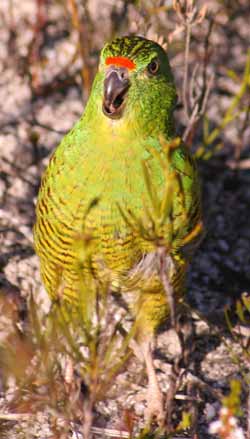DNA Uncovers One of the World's Rarest Birds

An adult Western Ground Parrot photographed in Fitzgerald River National Park, Western Australia. Photo by Brent Barrett, WA Department of Environment and Conservation.<br>
The team, led by Australian Wildlife Conservancy's Dr Stephen Murphy, used DNA from museum specimens up to 160 years old to reveal that populations of ground parrots in eastern and western Australia are highly distinct from each other and that the western populations should be recognized as a new species, Pezoporus flaviventris.
“The discovery has major conservation implications,” said Dr Murphy. “The Western Ground parrot has declined rapidly in the last 20 years, there are now only about 110 birds surviving in the wild and most of these are confined to a single national park. It is now one of the world's rarest birds.”
WA Department of Environment and Conservation's Dr Allan Burbidge said: “A single wildfire through the national park or an influx of introduced predators, such as cats, could rapidly push the species to extinction. There is now an urgent need to prevent further population declines and to establish insurance populations into parts of the former range.”
“Our findings demonstrate that museum collections, some going back more than 150 years, continue to be relevant and can provide critical information for understanding and conserving the world's biodiversity into the future,” said team member Dr Jeremy Austin, Deputy Director of the Australian Centre for Ancient DNA at the University of Adelaide.
Director of CSIRO's Australian National Wildlife Collection, Dr Leo Joseph, said: “Even after 200 years of study, we are still recognizing new species of birds in Australia. This finding highlights the need for further research on Australia's unique, and sometimes cryptic, biodiversity.”
The team's findings have been published this month in the international conservation research journal Conservation Genetics.
Media Contact
More Information:
http://www.adelaide.edu.auAll latest news from the category: Life Sciences and Chemistry
Articles and reports from the Life Sciences and chemistry area deal with applied and basic research into modern biology, chemistry and human medicine.
Valuable information can be found on a range of life sciences fields including bacteriology, biochemistry, bionics, bioinformatics, biophysics, biotechnology, genetics, geobotany, human biology, marine biology, microbiology, molecular biology, cellular biology, zoology, bioinorganic chemistry, microchemistry and environmental chemistry.
Newest articles

Silicon Carbide Innovation Alliance to drive industrial-scale semiconductor work
Known for its ability to withstand extreme environments and high voltages, silicon carbide (SiC) is a semiconducting material made up of silicon and carbon atoms arranged into crystals that is…

New SPECT/CT technique shows impressive biomarker identification
…offers increased access for prostate cancer patients. A novel SPECT/CT acquisition method can accurately detect radiopharmaceutical biodistribution in a convenient manner for prostate cancer patients, opening the door for more…

How 3D printers can give robots a soft touch
Soft skin coverings and touch sensors have emerged as a promising feature for robots that are both safer and more intuitive for human interaction, but they are expensive and difficult…





















